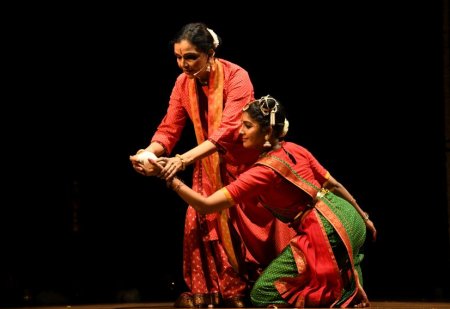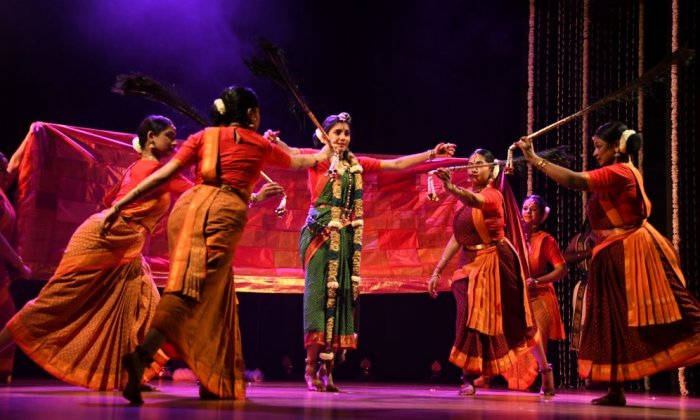
|   |

|   |
An extraordinary evening when Andal visited us onstage - Dr. Ratna Raman e-mail: ramanratna@gmail.com Photos: Adarsh Sahni May 20, 2024 I went to watch the show 'Naachiyar Next' in a week that began with Holi, the North's spectacular display of colour and abandon, bidding farewell to winter and speaking of rejuvenation, of the body and the being, perhaps even the liberation of the spirit. Anita Ratnam has brought Andal to Delhi theatre goers before. At the end of my first meeting with Anita, I remember thinking that if Hema Malini's mother had met her instead of Meenakshi Seshadri, she would have been adopted perhaps for her fabulously sculpted dancer's body and face. Nevertheless, 'Neelam-Drowning in Bliss', the show that Anita brought to Delhi a decade ago, despite the stunning blue costume designed by Sandhya Raman, evoked a tepid response. It was charming and aesthetic and Anita transformed gender seamlessly in her appropriation of a masculine divinity, but it was not a performance that provided exhilarating moments in which one could no longer tell the dancer from the dance, (a line paraphrased from W. B. Yeats's poem, Sailing to Byzantium), which for me has always been an important criterion as a rasika.  'Naachiyar Next' which Anita choreographed, performed, directed and produced and brought to Delhi on 31st March 2024 was an extraordinary show brilliantly choreographed and rendered by a troupe. The costumes in cotton shungadi, part of Sandhya Raman's design to make the warp and weft of fabric speak its own truth, effortlessly evoked the Tamil heartland, and what young women in the village would be routinely dressed in. Anita's costume was a shungadi kurta, with a flowing shungadi full-skirt beneath, elegantly rustic and in command of the situation as the narrative unfolded. Abundant rhythmic music interspersed with focused snippets of conversation in English added to the heightened experience. This was a story about a young woman, growing up and coming of age in a closely knit community, with all its attendant joys and sorrows. Instead of the solitary Andal seen in countless Bharatanatyam repertoires, this version gave us a young adolescent girl, growing up in her community with her peers and an older father, and an older woman, all of whom contribute to her coming of age in a substantial manner. Andal's discovery of her sexuality, her falling in love with Godhead and her passionate espousal of her desires made for extraordinary high voltage rendering on the stage and each member of the troupe contributed admirably in this dramatic presentation. Each viewer was swept into the story, and made to invest in the quicksilver emotions of Andal, the sympathy of her peers as they tried to empathise with the high voltage experiences that Andal was undergoing, while the anxious father, priest and upholder of community value is made to rework all his earlier assumptions.  Andal's story speaks to the eternal woman, who has to work out her material and spiritual destiny, in the midst of restrictive codes and practices. Andal's merging with Godhead, provided a glimpse of the sublime, rarely seen on the stage. Anita Ratnam's brilliant production reiterates that dreams and desires passionately charted lead up to self-fulfillment, reminding us that commitment must emerge from the most adverse of situations and that when it comes to the crunch, older members, parents and religious guardians not only enable transformative possibilities but make way for and become part of new and more inclusive spaces. In the diminished and truncated modernity that we inhabit, Anita's Andal, through an excellent resuscitation of this ancient tale, offers renewed hope and direction for all contemporary viewers and seekers, reminding us that social and spiritual emancipation is a slow ongoing process in human existence.  Dr. Ratna Raman is a professor teaching Englih literature at Sri Venkateswara College, one of the constituent colleges of Delhi University. She is deeply interested in literature, theatre and the fine arts, women' s rights and the cultural contexts from which narratives unfold. |